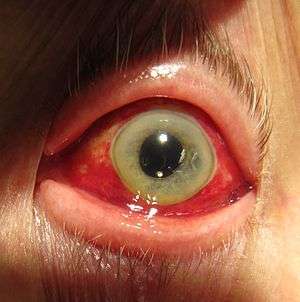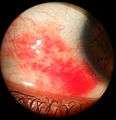Subconjunctival bleeding
Subconjunctival bleeding, also known as subconjunctival hemorrhage, is bleeding from a small blood vessel in the outer layer of the eye (the conjunctiva) into the space between the conjunctiva and the sclera.[1] It results in a red spot in the white of the eye.
| Subconjunctival bleeding | |
|---|---|
| Other names | Subconjunctival hemorrhage, subconjunctival haemorrhage, hyposphagma |
 | |
| Subconjunctival hemorrhage resulting in red coloration of the white of the eye. | |
| Specialty | Ophthalmology |
Causes include sneezing or coughing, high blood pressure, blood thinners such as aspirin or warfarin, heavy lifting, vomiting, rubbing the eye too vigorously, being choked, straining, trauma to the eye, after eye surgery such as LASIK, and atmospheric pressure changes such as those which occur with diving and airplane ascent and descent.[2][3]
Diagnosis is by visual inspection of the eye. The condition is not dangerous and resolves spontaneously within two weeks. No treatment is needed for resolution; artificial tears may be used for eye discomfort.
Signs and symptoms
A subconjunctival bleeding usually does not result in pain, although occasionally the affected eye may feel dry, rough, or scratchy.
A subconjunctival bleeding initially appears bright-red underneath the transparent conjunctiva. Later, the bleeding may spread and become green or yellow as the hemoglobin is metabolized. It usually disappears within 2 weeks.[4]
 (Top) A stress induced subconjunctival bleeding in the left eye one week after hemorrhaging.
(Top) A stress induced subconjunctival bleeding in the left eye one week after hemorrhaging. Subconjunctival bleeding viewed through a slit lamp biomicroscope
Subconjunctival bleeding viewed through a slit lamp biomicroscope- Subconjunctival bleeding in the left eye 48 hours after the onset of hemorrhaging.
Causes
- It may result from being choked
- Certain infections of the outside of the eye (conjunctivitis) where a virus or a bacteria weaken the walls of small blood vessels under the conjunctiva
- Mask squeeze from diving and not equalizing mask pressure during descent
- Eye trauma
- Coagulation disorder (congenital or acquired)
- Head injury
- Whooping cough or other extreme sneezing or coughing[2]
- Severe hypertension
- LASIK
- Acute hemorrhagic conjunctivitis (caused by Enterovirus 70 or Coxsackie A virus)
- Leptospirosis
- Ebola
- Increased venous pressure (e.g., extreme g-force, straining, vomiting, choking, or coughing)[2][3] or from straining due to constipation
- Zygoma fracture (results in lateral subconjunctival bleeding)
Subconjunctival bleeding in infants may be associated with scurvy (a vitamin C deficiency),[5][6] abuse or traumatic asphyxia syndrome.[7]
Diagnosis
Diagnosis is by visual inspection, by noting the typical finding of bright red discoloration confined to the white portion (sclera) of the eye.
Management
A subconjunctival bleeding is typically a self-limiting condition that requires no treatment unless there is evidence of an eye infection or there has been significant eye trauma. The elective use of aspirin and NSAIDs is typically discouraged. Artificial tears may be applied four to six times a day if the eye feels dry or scratchy .[8]
References
- "What is a Subconjunctival Hemorrhage?". American Academy of Ophthalmology. 3 July 2019. Retrieved 17 October 2019.
- "Subconjunctival hemorrhage". PubMed Health on the National Institutes of Health website. May 1, 2011. Retrieved October 15, 2012.
- "Subconjunctival hemorrhage". Disease.com. n.d. Retrieved October 15, 2012.
- Robert H. Grahamn (February 2009). "Subconjunctival Hemorrhage". emedicine.com. Retrieved 23 November 2010.
- "Möller-Barlow disease". whonamedit.com. Retrieved 23 November 2010.
- Bruce M. Rothschild (December 17, 2008). "Scurvy". eMedicine.com. Retrieved 23 November 2010.
- Spitzer S. G; Luorno J.; Noël L. P. "Isolated subconjunctival hemorrhages in nonaccidental trauma". doi:10.1016/j.jaapos.2004.10.003. PMID 15729281. Cite journal requires
|journal=(help) - Robert H. Grahamn (February 2009). "Subconjunctival Hemorrhage". emedicine.com. Retrieved 23 November 2010.
External links
| Classification | |
|---|---|
| External resources |
| Wikimedia Commons has media related to Subconjunctival hemorrhage. |